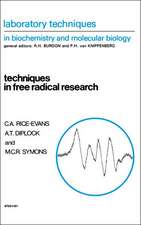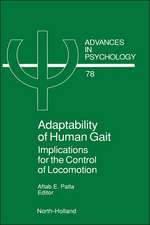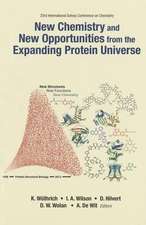Biology of Serpins: Methods in Enzymology, cartea 499
Editat de James Whisstock, Phillip Birden Limba Engleză Hardback – 25 aug 2011
Din seria Methods in Enzymology
-
 Preț: 390.54 lei
Preț: 390.54 lei -
 Preț: 391.30 lei
Preț: 391.30 lei -
 Preț: 392.01 lei
Preț: 392.01 lei -
 Preț: 391.01 lei
Preț: 391.01 lei - 28%
 Preț: 801.23 lei
Preț: 801.23 lei - 32%
 Preț: 802.54 lei
Preț: 802.54 lei - 23%
 Preț: 461.36 lei
Preț: 461.36 lei - 23%
 Preț: 460.60 lei
Preț: 460.60 lei - 23%
 Preț: 439.86 lei
Preț: 439.86 lei - 23%
 Preț: 448.15 lei
Preț: 448.15 lei - 23%
 Preț: 451.42 lei
Preț: 451.42 lei - 23%
 Preț: 445.18 lei
Preț: 445.18 lei - 5%
 Preț: 557.15 lei
Preț: 557.15 lei - 23%
 Preț: 450.67 lei
Preț: 450.67 lei - 23%
 Preț: 446.23 lei
Preț: 446.23 lei - 23%
 Preț: 435.87 lei
Preț: 435.87 lei - 23%
 Preț: 445.94 lei
Preț: 445.94 lei - 23%
 Preț: 459.55 lei
Preț: 459.55 lei - 23%
 Preț: 460.02 lei
Preț: 460.02 lei - 23%
 Preț: 450.54 lei
Preț: 450.54 lei - 23%
 Preț: 453.47 lei
Preț: 453.47 lei - 5%
 Preț: 565.37 lei
Preț: 565.37 lei - 23%
 Preț: 450.67 lei
Preț: 450.67 lei - 23%
 Preț: 464.33 lei
Preț: 464.33 lei - 23%
 Preț: 441.49 lei
Preț: 441.49 lei - 23%
 Preț: 447.44 lei
Preț: 447.44 lei - 23%
 Preț: 459.13 lei
Preț: 459.13 lei - 23%
 Preț: 450.38 lei
Preț: 450.38 lei - 23%
 Preț: 445.80 lei
Preț: 445.80 lei - 23%
 Preț: 445.35 lei
Preț: 445.35 lei - 23%
 Preț: 442.53 lei
Preț: 442.53 lei - 23%
 Preț: 450.38 lei
Preț: 450.38 lei - 23%
 Preț: 448.60 lei
Preț: 448.60 lei - 23%
 Preț: 447.57 lei
Preț: 447.57 lei - 23%
 Preț: 440.90 lei
Preț: 440.90 lei - 23%
 Preț: 448.15 lei
Preț: 448.15 lei - 23%
 Preț: 466.84 lei
Preț: 466.84 lei - 23%
 Preț: 451.42 lei
Preț: 451.42 lei - 23%
 Preț: 453.64 lei
Preț: 453.64 lei - 23%
 Preț: 459.13 lei
Preț: 459.13 lei - 23%
 Preț: 457.49 lei
Preț: 457.49 lei - 23%
 Preț: 447.44 lei
Preț: 447.44 lei - 5%
 Preț: 561.34 lei
Preț: 561.34 lei - 23%
 Preț: 447.57 lei
Preț: 447.57 lei - 23%
 Preț: 453.35 lei
Preț: 453.35 lei - 23%
 Preț: 441.95 lei
Preț: 441.95 lei - 23%
 Preț: 450.38 lei
Preț: 450.38 lei - 23%
 Preț: 449.19 lei
Preț: 449.19 lei - 23%
 Preț: 456.02 lei
Preț: 456.02 lei
Preț: 849.06 lei
Preț vechi: 1243.70 lei
-32% Nou
Puncte Express: 1274
Preț estimativ în valută:
162.49€ • 169.01$ • 134.14£
162.49€ • 169.01$ • 134.14£
Carte tipărită la comandă
Livrare economică 07-21 aprilie
Preluare comenzi: 021 569.72.76
Specificații
ISBN-13: 9780123864710
ISBN-10: 0123864712
Pagini: 456
Dimensiuni: 152 x 229 x 30 mm
Editura: ELSEVIER SCIENCE
Seria Methods in Enzymology
ISBN-10: 0123864712
Pagini: 456
Dimensiuni: 152 x 229 x 30 mm
Editura: ELSEVIER SCIENCE
Seria Methods in Enzymology
Public țintă
Researchers and students in cell, molecular and developmental biologyCuprins
- Analysis of Serpin Secretion, Misfolding and Surveilance in the Endoplasmic Reticulum
Shujuan Pan, Michael J. Iannotti and Richard N. Sifers
- Serpin-Enzyme Receptors: Ldl Receptor Related Protein 1
Dudley K. Strickland, Selen Catania Muratoglu and Toni M. Antalis
- The Role of Autophagy in Alpha-1-Antitrypsin Deficiency
Tunda Hidvegi, Amitava Mukherjee, Michael Ewing, Carolyn Kemp and David H. Perlmutter
- Serpins and the Complement System
László Beinrohr, Thomas A. Murray-Rust, Leanne Dyksterhuis, Péter Závodszky, Péter Gál, Robert N. Pike and Lakshmi C. Wijeyewickrema
- Use of Mouse Models to Study Plasminogen Activator Inhibitor-1
Paul J. Declerck, Ann Gils and Bart De Taeye
- Plasminogen Activator Inhibitor Type 2: Still An Enigmatic Serpin But A Model For Gene Regulation
Robert L. Medcalf
- The Serpinb1 Knock-Out Mouse: A Model For Studying Neutrophil Protease Regulation in Homeostasis and Inflammation
Charaf Benarafa
- Investigating Maspin in Breast Cancer Progression Using Mouse Models
Michael P. Endsley and Ming Zhang
- Hsp47as A Collagen-Specific Molecular Chaperone
Yoshihito Ishida and Kazuhiro Nagata
- Assays for the Antiangiogenic and Neurotrophic Serpin Pigment Epithelium‐Derived Factor
S. Patricia Becerra, Susan E. Crawford and Preeti Subramanian
- The Drosophila Serpins: Multiple Functions in Immunity and Morphogenesis
Jean Marc Reichhart, David Gubb and Vincent Leclerc
- Modelling Serpin Conformational Diseases in Drosophila Melanogaster
Thomas R. Jahn, Elke Malzer, John Roote, Anastasia Vishnivetskaya, Sara Imarisio, Maria Giannakou, Karin Panser, Stefan Marciniak, Damian C. Crowther
- Using Caenorhabditis Elegans to Study Serpinopathies
Olivia S. Long, Sager J. Gosai, Joon Hyeok Kwak, Dale E. King, David H. Perlmutter, Gary A. Silverman and Stephen C. Pak
- Using c. Elegans to Identify the Protease Targets of Serpins In Vivo.
Sangeeta R. Bhatia, Mark T. Miedel, Cavita K. Chotoo, Nathan J. Graf, Brian L. Hood, Thomas P. Conrads, Gary A. Silverman and Cliff J. Luke
- Viral Serpin Therapeutics: From Concept to Clinic
Hao Chen, MD, PhD, Donghang Zheng, MD, PhD, Jennifer Davids, BA, Mee Yong Bartee, PhD, Erbin Dai, MD, Liying Liu, MD, Lyubomir Petrov, MD, PhD, Colin Macaulay, PhD, Robert Thoburn, MD, Eric Sobel, MD, PhD, Richard Moyer, PhD, Grant McFadden, PhD, Alexandra Lucas, MD, FRCP(C)
- Human Scca Serpins Inhibit Staphylococcal Cysteine Proteases by Forming Classic "Serpin-Like" Covalent Complexes
Tomasz Kantyka and Jan Potempa
- Plants and the Study of Serpin Biology











